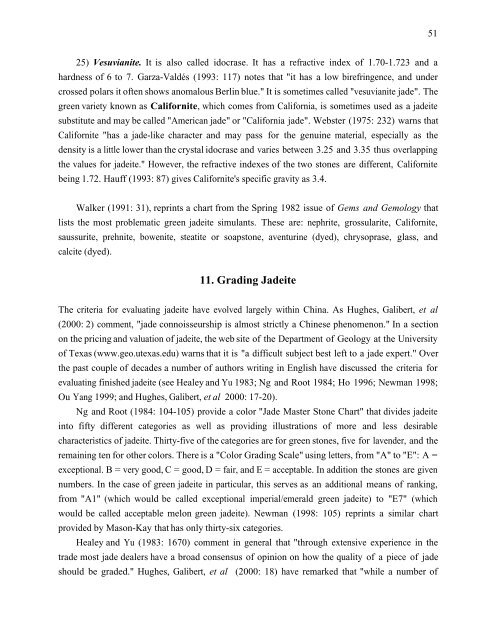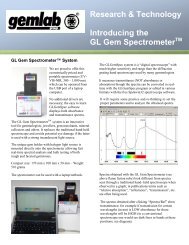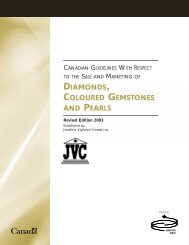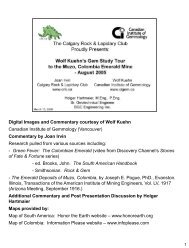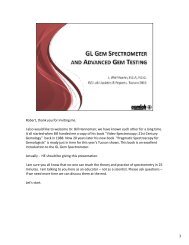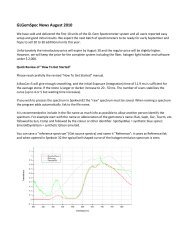JADEITE - Canadian Institute of Gemmology
JADEITE - Canadian Institute of Gemmology
JADEITE - Canadian Institute of Gemmology
Create successful ePaper yourself
Turn your PDF publications into a flip-book with our unique Google optimized e-Paper software.
25) Vesuvianite. It is also called idocrase. It has a refractive index <strong>of</strong> 1.70-1.723 and a<br />
hardness <strong>of</strong> 6 to 7. Garza-Valdés (1993: 117) notes that "it has a low birefringence, and under<br />
crossed polars it <strong>of</strong>ten shows anomalous Berlin blue." It is sometimes called "vesuvianite jade". The<br />
green variety known as Californite, which comes from California, is sometimes used as a jadeite<br />
substitute and may be called "American jade" or "California jade". Webster (1975: 232) warns that<br />
Californite "has a jade-like character and may pass for the genuine material, especially as the<br />
density is a little lower than the crystal idocrase and varies between 3.25 and 3.35 thus overlapping<br />
the values for jadeite." However, the refractive indexes <strong>of</strong> the two stones are different, Californite<br />
being 1.72. Hauff (1993: 87) gives Californite's specific gravity as 3.4.<br />
Walker (1991: 31), reprints a chart from the Spring 1982 issue <strong>of</strong> Gems and Gemology that<br />
lists the most problematic green jadeite simulants. These are: nephrite, grossularite, Californite,<br />
saussurite, prehnite, bowenite, steatite or soapstone, aventurine (dyed), chrysoprase, glass, and<br />
calcite (dyed).<br />
11. Grading Jadeite<br />
The criteria for evaluating jadeite have evolved largely within China. As Hughes, Galibert, et al<br />
(2000: 2) comment, "jade connoisseurship is almost strictly a Chinese phenomenon." In a section<br />
on the pricing and valuation <strong>of</strong> jadeite, the web site <strong>of</strong> the Department <strong>of</strong> Geology at the University<br />
<strong>of</strong> Texas (www.geo.utexas.edu) warns that it is "a difficult subject best left to a jade expert." Over<br />
the past couple <strong>of</strong> decades a number <strong>of</strong> authors writing in English have discussed the criteria for<br />
evaluating finished jadeite (see Healey and Yu 1983; Ng and Root 1984; Ho 1996; Newman 1998;<br />
Ou Yang 1999; and Hughes, Galibert, et al 2000: 17-20).<br />
Ng and Root (1984: 104-105) provide a color "Jade Master Stone Chart" that divides jadeite<br />
into fifty different categories as well as providing illustrations <strong>of</strong> more and less desirable<br />
characteristics <strong>of</strong> jadeite. Thirty-five <strong>of</strong> the categories are for green stones, five for lavender, and the<br />
remaining ten for other colors. There is a "Color Grading Scale" using letters, from "A" to "E": A =<br />
exceptional. B = very good, C = good, D = fair, and E = acceptable. In addition the stones are given<br />
numbers. In the case <strong>of</strong> green jadeite in particular, this serves as an additional means <strong>of</strong> ranking,<br />
from "A1" (which would be called exceptional imperial/emerald green jadeite) to "E7" (which<br />
would be called acceptable melon green jadeite). Newman (1998: 105) reprints a similar chart<br />
provided by Mason-Kay that has only thirty-six categories.<br />
Healey and Yu (1983: 1670) comment in general that "through extensive experience in the<br />
trade most jade dealers have a broad consensus <strong>of</strong> opinion on how the quality <strong>of</strong> a piece <strong>of</strong> jade<br />
should be graded." Hughes, Galibert, et al (2000: 18) have remarked that "while a number <strong>of</strong><br />
51


